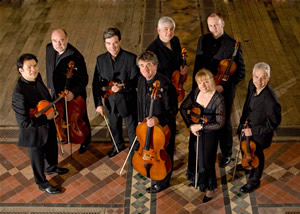Local arts outreach programs helped fill Fletcher Opera Theater for the Academy of St. Martin in the Fields Chamber Ensemble program featuring octets by Mendelssohn and Shostakovich. Violinist and guest leader Andrew Watkinson apologized from the stage for extensive program changes necessitated by a violinist’s illness. While many may well have been disappointed by the loss of the famous Mendelssohn Op. 20 octet, the Academy’s all-sextet substitutions could not have been more winning.
The String Sextet in B-flat, Op. 18 of Johannes Brahms has an extraordinary range of string texture over the course of its four movements. The work finds the composer in an unusua,lly sunny mood and is characterized by an almost naïve directness of expression. According to Melvin Berger in Guide to Chamber Music, there are three distinct melodies in the first movement: “the first, a warm, rich line sung by the first cello; the second, a fleeting, descending figure in the first violin; and the third, a languorous waltz given out by the entire ensemble.” The second movement is slow and opens with the first viola playing a “rugged Hungarian Gypsy melody” followed by six of the composer’s masterful variations. The “bright and bouncy” scherzo features some false accents and a really galloping middle Trio section. The opening of the finale has a Mozartean charm followed by “a more dramatic second theme played by the violins and violas.” The coda accelerates to a rousing conclusion.
The Academy’s string players produced wonderfully full and rich string tone in ensemble while individual solos, such as the cello in the first movement or the viola in the second, were gorgeously individual with superb intonation and phrasing throughout.
Richard Strauss’ final opera, Capriccio, has opera itself as its subject. Set in France at the time of Gluck’s reforms, two idealistic rivals for the Countess, a poet and a musician, argue whether words or music are the more important, with the Countess’ cynical brother, who is a theatrical manager. The opera opens with the sound of a string sextet heard offstage. The Academy conjured up this marvelously civilized musical argument with seemingly effortless grace.
Only the Sextet in A, Op. 48, by Antonín Dvorák was retained from the Raleigh Chamber Music Guild‘s printed program. It was composed in May 1878 soon after his highly successful first series of Slavonic Dances. The first movement is in the sonata form and built around the opening lyrical theme. The middle two movements make extensive use of Czech folk idioms. The second is based upon an elegiac Dumka, a Slavonic lament with frequent sudden changes of mood. The third is a lively Furiant and in a foot-stomping ¾ time. The Finale is a set of six variations upon a theme with strongly contrasted moods and melodies leading to an exciting end. The Academy played with controlled abandon and turned in a superbly idiomatic performance. Bravo!
Most Raleigh Chamber Music Guild concerts are preceded by a guest youth ensembles reflecting the organization’s extensive educational outreach programs. A string trio from Davis Drive Middle School, Cary, played the first and third movements from Dvorák’s delightful Terzetto in C, Op. 74. The violinists were Michael An and Clare Yu and the violist was Dominick Boyle.
Their coach is Johanna Rogers. The pre-concert lecture, “The Joy of Chamber Music: Performer’s Art/Listener’s Art,” was given by Jonathan Kramer who is Teaching Professor of Music and Arts Studies at NC State University and Adjunct Professor of Ethnomusicology at Duke University.












